Influence of Bottom Substrate, Bottom Depth and Day/Night on In Situ Coloration Variability of Pomatoschistus minutus (Pallas, 1770) (Actinopterygii: Oxudercidae)
Abstract
1. Introduction
2. Materials and Methods
2.1. Studied Area and Sampling
2.2. Morphological Identification
2.3. Sediment Analysis
2.4. Image Processing and Data Analysis
2.4.1. Dataset Description
2.4.2. Image Processing and Color Detection
2.4.3. Statistical Analysis of Color Variation
2.5. Coloration Description
3. Results
3.1. Species Identification and Sample Composition
3.2. Influence of Bottom Composition, Depth, Time of Day, Sex, and Developmental Stage on Quantified Coloration Variability of P. minutus
3.3. Qualitative Description of In Situ Live Coloration Pattern of P. minutus
4. Discussion
5. Conclusions
Supplementary Materials
Author Contributions
Funding
Institutional Review Board Statement
Informed Consent Statement
Data Availability Statement
Acknowledgments
Conflicts of Interest
Abbreviation
| PMR | Prirodoslovni muzej Rijeka/the Natural History Museum Rijeka |
References
- Puebla, O.; Bermingham, E.; Guichard, F.; Whiteman, E. Color pattern as a single trait driving speciation in Hypoplectrus coral reef fishes? Proc. R. Soc. B 2007, 274, 1265–1271. [Google Scholar] [CrossRef]
- Nilsson Sköld, H.; Svensson, P.A.; Zejlon, C. The capacity for internal color change is related to body transparency in fishes. Pigment Cell Melanoma Res. 2010, 23, 292–295. [Google Scholar] [CrossRef]
- Kovačić, M.; Bogorodsky, S.V. A new species of Hetereleotris (Perciformes: Gobiidae) from the Red Sea. Zootaxa 2014, 3764, 475–481. [Google Scholar] [CrossRef] [PubMed]
- Maeda, K.; Kobayashi, H.; Palla, H.P.; Shinzato, C.; Koyanagi, R.; Montenegro, J.; Nagano, A.J.; Saeki, T.; Kunishima, T.; Yamahira, K. Do color-morphs of an amphidromous goby represent different species? Taxonomy of Lentipes (Gobiiformes) from Japan and Palawan, Philippines, with phylogenomic approaches. Syst. Biodivers. 2021, 19, 1080–1112. [Google Scholar] [CrossRef]
- Kovačić, M.; Renoult, J.P.; Pillon, R.; Svensen, R.; Bogorodsky, S.; Engin, S.; Louisy, P. Identification of Mediterranean marine gobies (Actinopterygii: Gobiidae) of the continental shelf from photographs of “in situ” individuals. Zootaxa 2022, 5144, 1–103. [Google Scholar] [CrossRef]
- Salis, P.; Lorin, T.; Laudet, V.; Frédérich, B. Magic Traits in Magic Fish: Understanding Color Pattern Evolution Using Reef Fish. Trends Genet. 2019, 35, 265–278. [Google Scholar] [CrossRef]
- Maan, M.E.; Sefc, K.M. Color variation in cichlid fish: Developmental mechanisms, selective pressures and evolutionary consequences. Semin. Cell Dev. Biol. 2013, 24, 516–528. [Google Scholar] [CrossRef]
- Herler, J.; Patzner, R.A.; Sturmbauer, C. A preliminary revision of the Gobius auratus species complex with redescription of Gobius auratus Risso, 1810. J. Nat. Hist. 2005, 39, 1043–1075. [Google Scholar] [CrossRef]
- Nilsson Sköld, H.; Aspengren, S.; Wallin, M. Rapid color change in fish and amphibians—Function, regulation, and emerging applications. Pigment Cell Melanoma Res. 2012, 26, 29–38. [Google Scholar] [CrossRef]
- Sumner, F.B. Quantitative changes in pigmentation resulting from visual stimuli in fishes and amphibia. Biol. Rev. Camb. Philos. Soc. 1940, 15, 351–375. [Google Scholar] [CrossRef]
- Miller, P.J. Gobiidae. In Fishes of the North-Eastern Atlantic and the Mediterranean; Whitehead, P.J.P., Bauchot, M.L., Hureau, M.L., Nielsen, J., Tortonese, E., Eds.; UNESCO: Paris, France, 1986; Volume 3, pp. 1019–1085. [Google Scholar]
- Kovačić, M.; Svensen, R.; Renoult, J.P.; Patzner, R.A. Checklist key and latitudinal distribution of the eastern Atlantic marine gobies along the European coast (Actinopterygii: Gobiidae and Oxudercidae). Zootaxa 2025, 5609, 1–28. [Google Scholar] [CrossRef]
- Swedmark, M. Sur la variation geographique de Gobius minutus Pallas. II. Caractères morphologiques, chromatiques et numeriques. Cah. Biol. Mar. 1968, 9, 297–345. [Google Scholar]
- Webb, C.J.; Miller, P.J. A redescription of Pomatoschistus norvegicus (Collett, 1903) (Teleostei: Gobioidei) based on syntype material. J. Fish Biol. 1974, 7, 735–747. [Google Scholar] [CrossRef]
- Webb, C.J. Systematics of the Pomatoschistus minutus complex (Teleostei: Gobioidei). Philos. Trans. R. Soc. B 1980, 291, 201–241. [Google Scholar]
- Hamerlynck, O. The identification of Pomatoschistus minutus (Pallas) and Pomatoschistus lozanoi (de Buen) (Pisces, Gobiidae). J. Fish Biol. 1990, 37, 723–728. [Google Scholar] [CrossRef]
- Louisy, P. Europe and Mediterranean Marine Fish Identification Guide, 3rd ed.; Eugen Ulmer: Paris, France, 2015; 512p. [Google Scholar]
- Nilsson Sköld, N.; Yngsell, D.; Mubashishir, M.; Wallin, M. Hormonal regulation of color change in eyes of a cryptic fish. Biol. Open 2015, 4, 206–211. [Google Scholar] [CrossRef]
- Engin, S.; Seyhan Öztürk, D. A new species of Pomatoschistus (Teleostei, Gobiidae): The Mediterranean’s smallest marine fish. J. Fish Biol. 2017, 91, 1208–1223. [Google Scholar] [CrossRef] [PubMed]
- Schliewen, U.K.; Wirtz, P.; Kovačić, M. Didogobius janetarum sp. nov., a new cryptobenthic goby species from the Cape Verde Islands (Teleostei: Gobiidae). Zootaxa 2018, 4438, 381–393. [Google Scholar] [CrossRef]
- Kovačić, M.; Svensen, R. Revision of Sanzo’s head lateral-line system (HLLS) classification and nomenclature based on its re-evaluation of almost all native Mediterranean and European Atlantic marine gobies. Spixiana 2024, 46, 229–295. [Google Scholar]
- Saruwatari, T.; López, J.A.; Pietsch, T.W. Cyanine Blue: A versatile and harmless stain for specimen observation. Copeia 1997, 1997, 840–841. [Google Scholar] [CrossRef]
- ISO 14688-1:2002; Geotechnical Investigation and Testing—Identification and Classification of Soil. ISO: Geneva, Switzerland, 2002. Available online: https://www.iso.org/standard/25260.html (accessed on 1 July 2025).
- Weller, H.I.; Westneat, M.W. Quantitative color profiling of digital images with earth mover’s distance using the R package colordistance. PeerJ 2019, 7, e6398. [Google Scholar] [CrossRef]
- Anderson, M.J. A new method for non-parametric multivariate analysis of variance. Austral Ecol. 2017, 26, 32–46. [Google Scholar]
- Oksanen, J.; Simpson, G.L.; Blanchet, F.G.; Kindt, R.; Legendre, P.; Minchin, P.R.; O‘Hara, R.G.; Solymos, P.; Stevens, M.H.H.; Szoecs, E.; et al. Vegan: Community Ecology Package, R package Version 2.5-7. 2020. Available online: https://CRAN.R-project.org/package=vegan (accessed on 1 September 2025).
- Van Belleghem, S.M.; Papa, R.; Ortiz- Zuazaga, H.; Hendrickx, F.; Jiggins, C.D.; McMillan, W.O.; Counterman, B.A. patternize: An R package for quantifying color pattern variation. Methods Ecol. Evol. 2018, 9, 390–398. [Google Scholar] [CrossRef] [PubMed]
- Hemingson, C.R.; Cowman, P.F.; Hodge, J.R.; Bellwood, D.R. Color pattern divergence in reef fish species is rapid and driven by both range overlap and symmetry. Ecol. Lett. 2019, 22, 190–199. [Google Scholar] [CrossRef]
- Hemingson, C.R.; Mihalitsis, M.; Bellwood, D.R. Are fish communities on coral reefs becoming less colorful? Glob. Change Biol. 2022, 28, 3321–3332. [Google Scholar] [CrossRef]
- Gerwin, J.; Urban, S.; Meyer, A.; Kratochwil, C.F. Of bars and stripes: A Malawi cichlid hybrid cross provides insights into genetic modularity and evolution of modifier loci underlying color pattern diversification. Mol. Ecol. 2021, 30, 4789–4803. [Google Scholar] [CrossRef]
- Deville, D.; Kawai, K.; Umino, T. Quantitative analysis of body coloration in Sebastes rockfishes. Mar. Biol. 2024, 171, 123. [Google Scholar] [CrossRef]
- John, L.; Rick, I.P.; Vitt, S.; Thünken, T. Body coloration as a dynamic signal during intrasexual communication in a cichlid fish. BMC Zool. 2021, 6, 9. [Google Scholar] [CrossRef]
- Marom, S.; Kiflawi, M.; Akkaynak, D.; Roi, R. Dynamic color change in the grouper Variola louti during interspecific interactions and swimming. Behav. Ecol. 2025, 36, araf005. [Google Scholar] [CrossRef]
- Williams, B.L.; Pintor, L.M.; Toomey, M.B.; Gray, S.M. Intraspecific Variation in Color and Carotenoids across Environmental Extremes in an African Cichlid. Ecol. Evol. Physiol. 2025, 98, 57–69. [Google Scholar] [CrossRef] [PubMed]
- Coulmance, F.; Akkaynak, D.; Le Poul, Y.; Höppner, M.P.; McMillan, W.O.; Puebla, O. Phenotypic and genomic dissection of color pattern variation in a reef fish radiation. Mol. Ecol. 2024, 33, e17047. [Google Scholar] [CrossRef] [PubMed]
- Yasir, I.; Qin, J.G. Effect of Light Intensity on Color Performance of False Clownfish, Amphiprion ocellaris Cuvier. J. World Aquac. Soc. 2009, 40, 337–350. [Google Scholar] [CrossRef]
- Cortesi, F.; Musilová, Z.; Stieb, S.M.; Hart, N.S.; Siebeck, U.E.; Cheney, K.L.; Salzburger, W.; Marshall, N.J. From crypsis to mimicry: Changes in color and the configuration of the visual system during ontogenetic habitat transitions in a coral reef fish. J. Exp. Biol. 2016, 219, 2545–2558. [Google Scholar] [CrossRef] [PubMed]
- European: Parliament; Council of the European Union. Directive 2010/63/EU of the European Parliament and of the e375Legislative Decree on experiments with animals Council of 22 September 2010 on the protection of animals used for scientific purposes. Off. J. Eur. Union 2010, L276, 33–79. [Google Scholar]
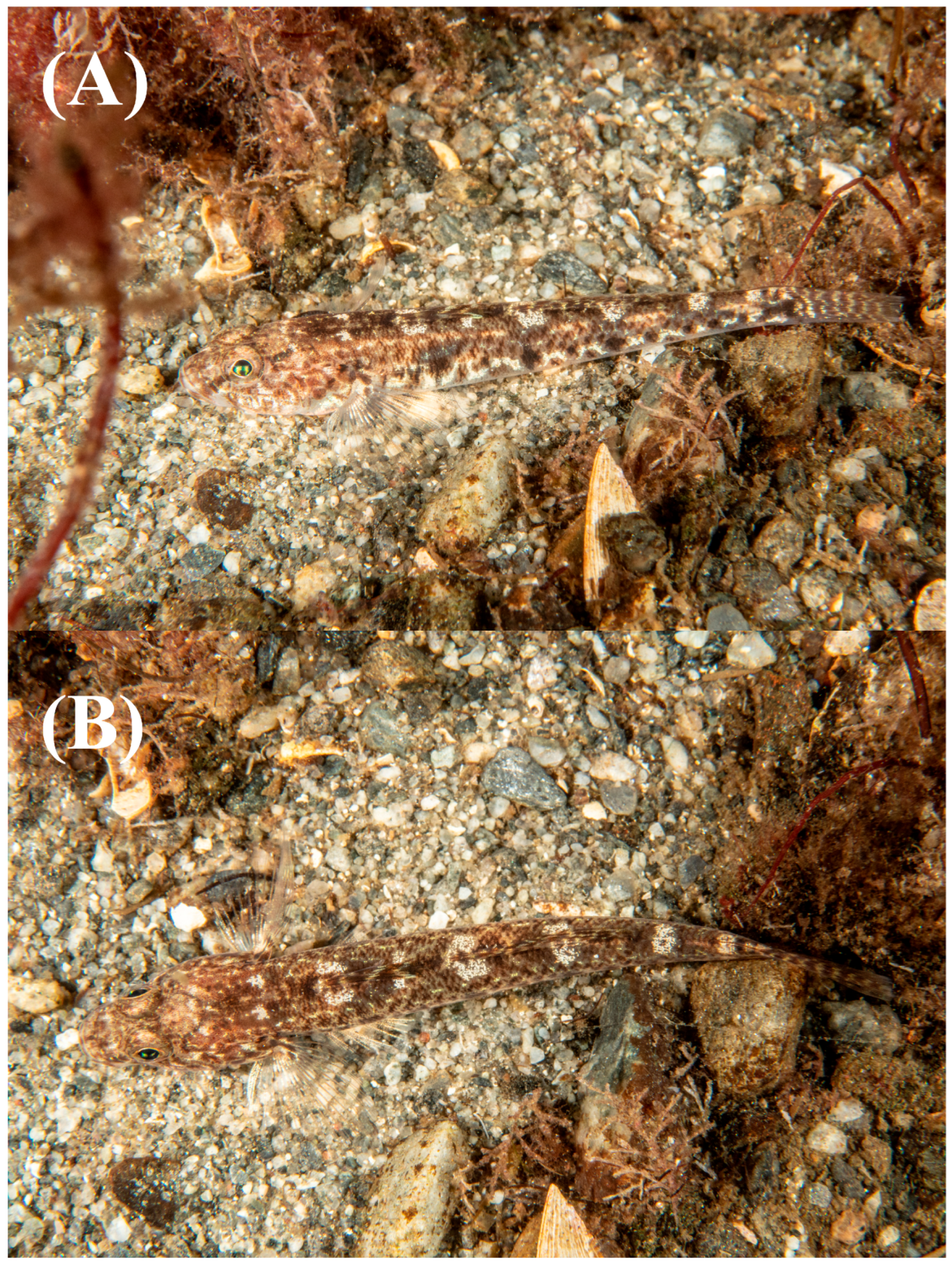
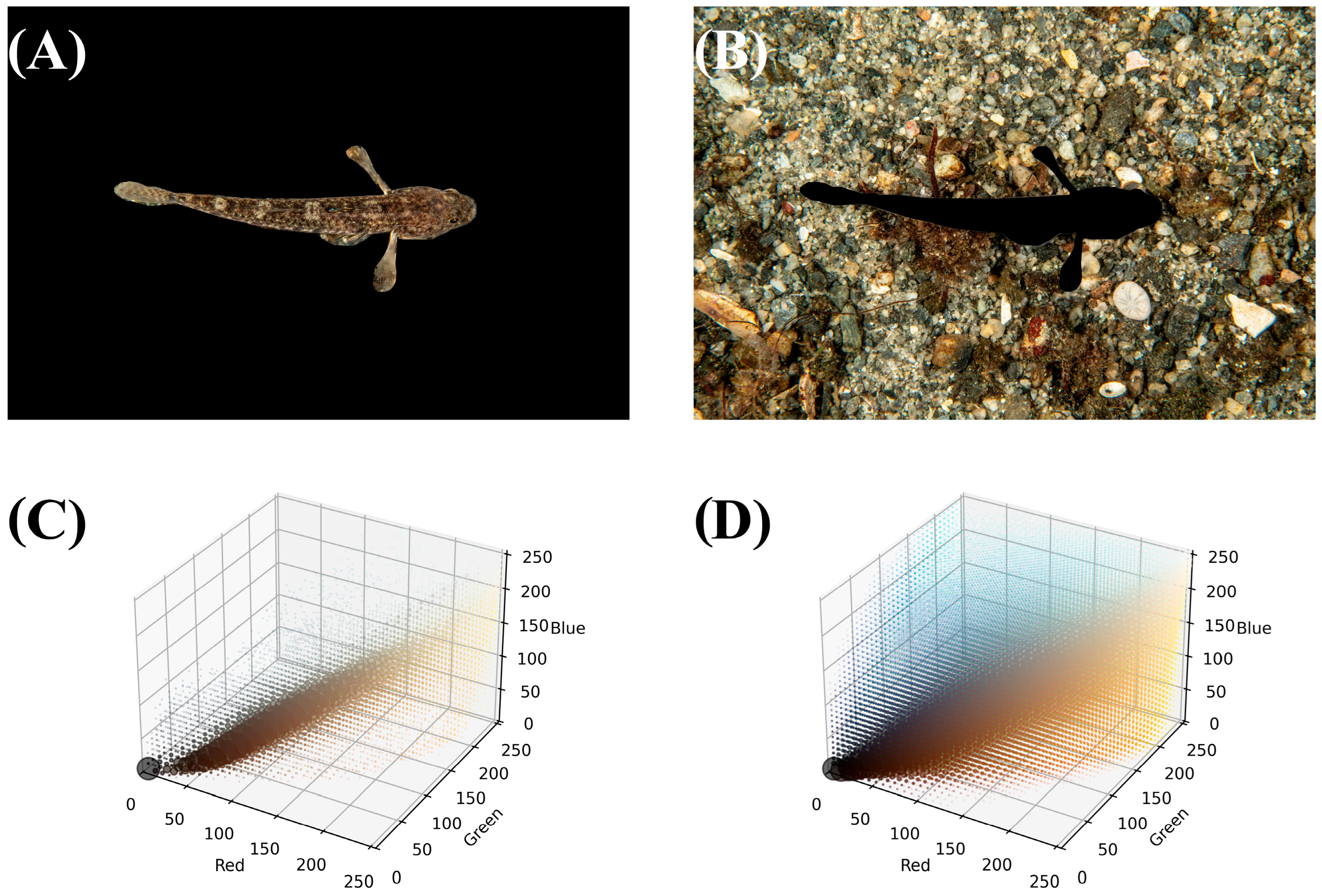
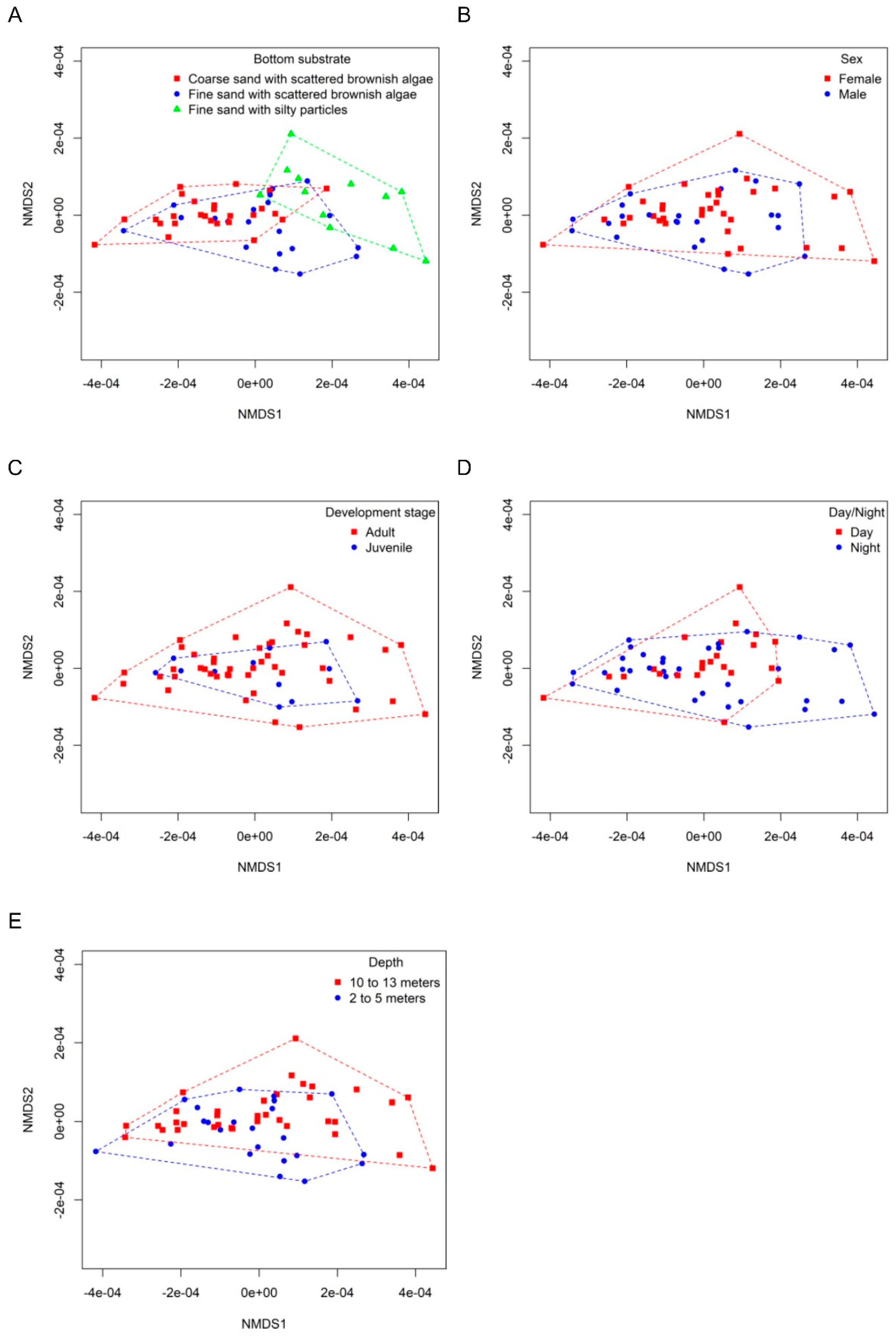
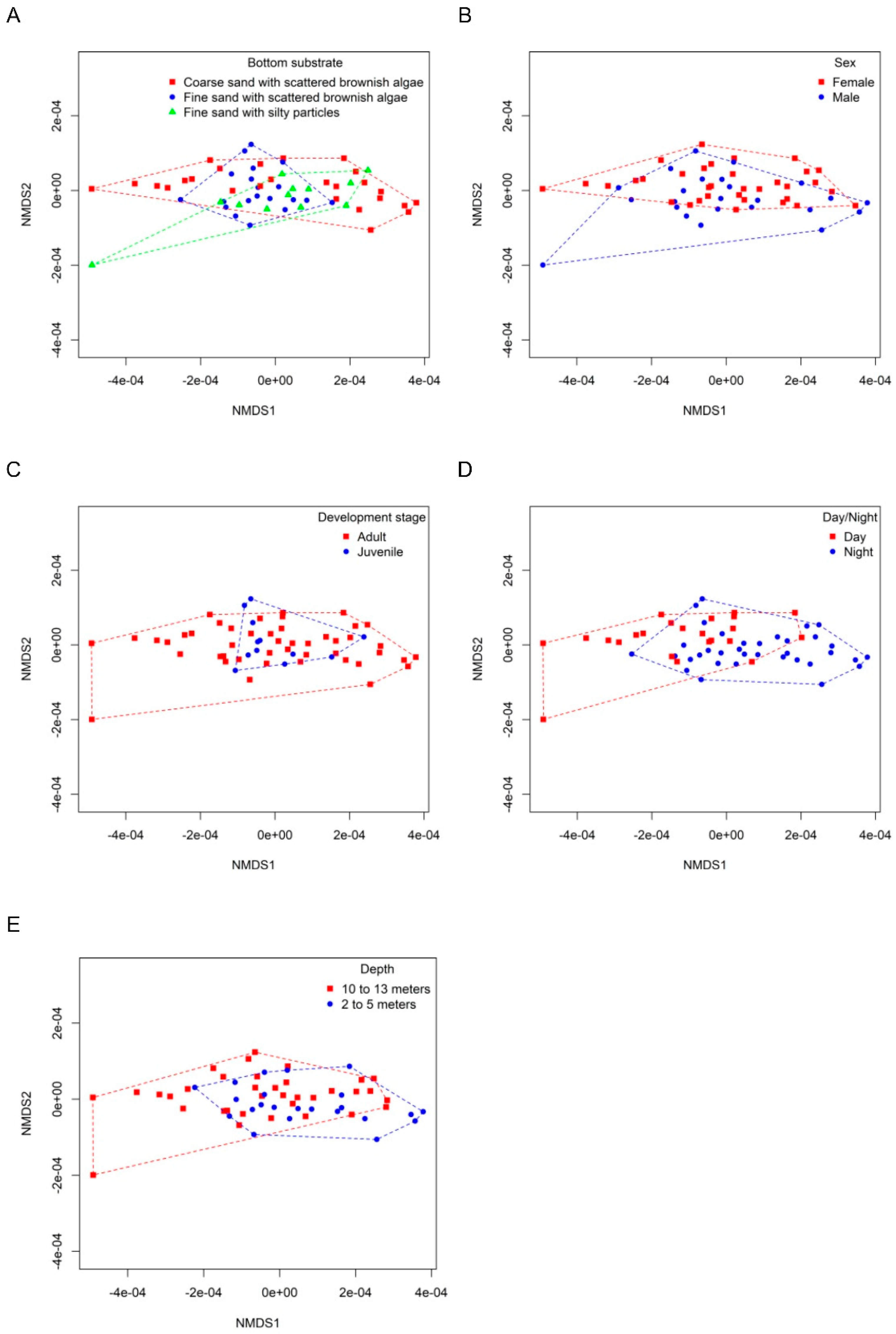
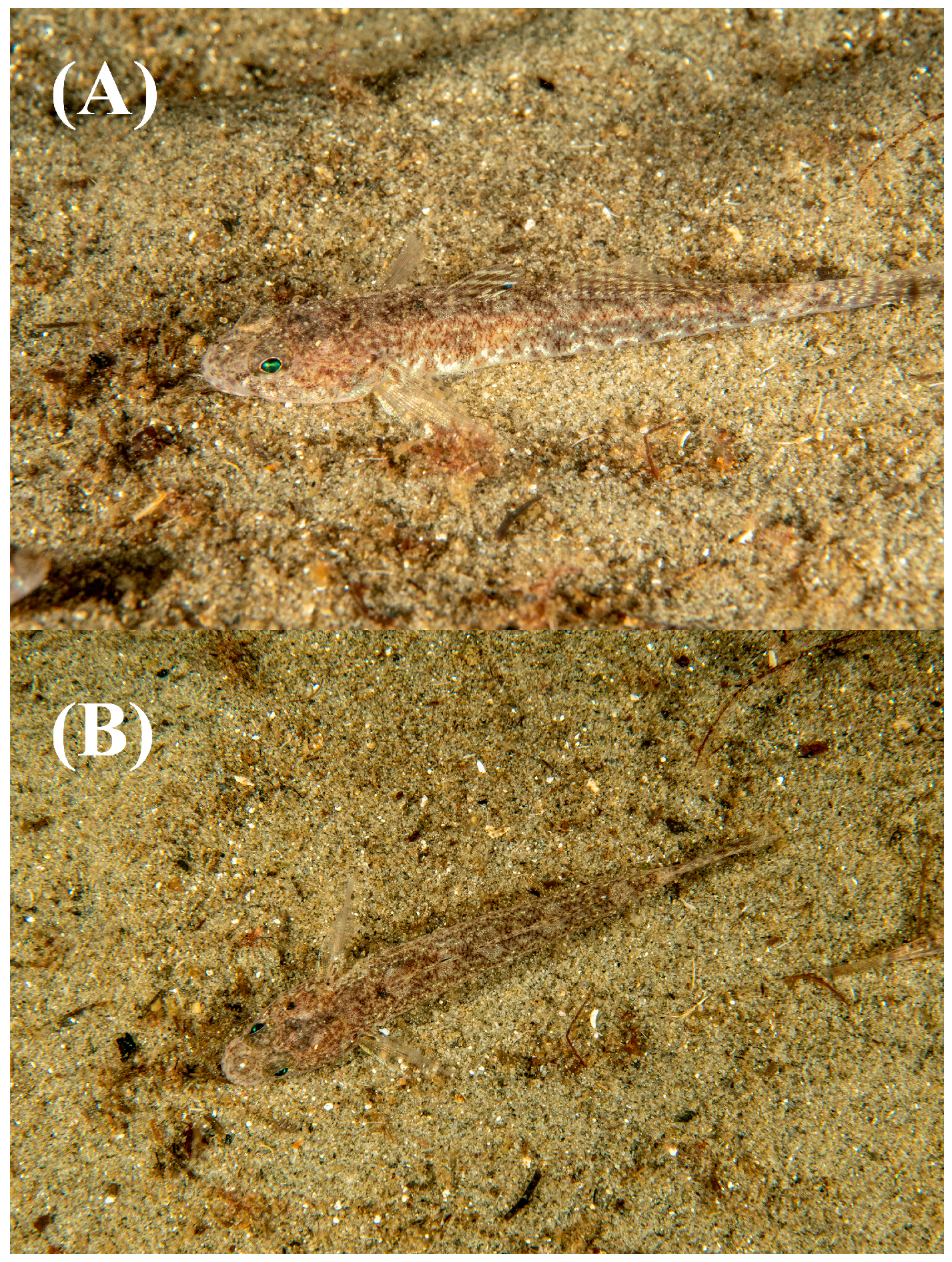
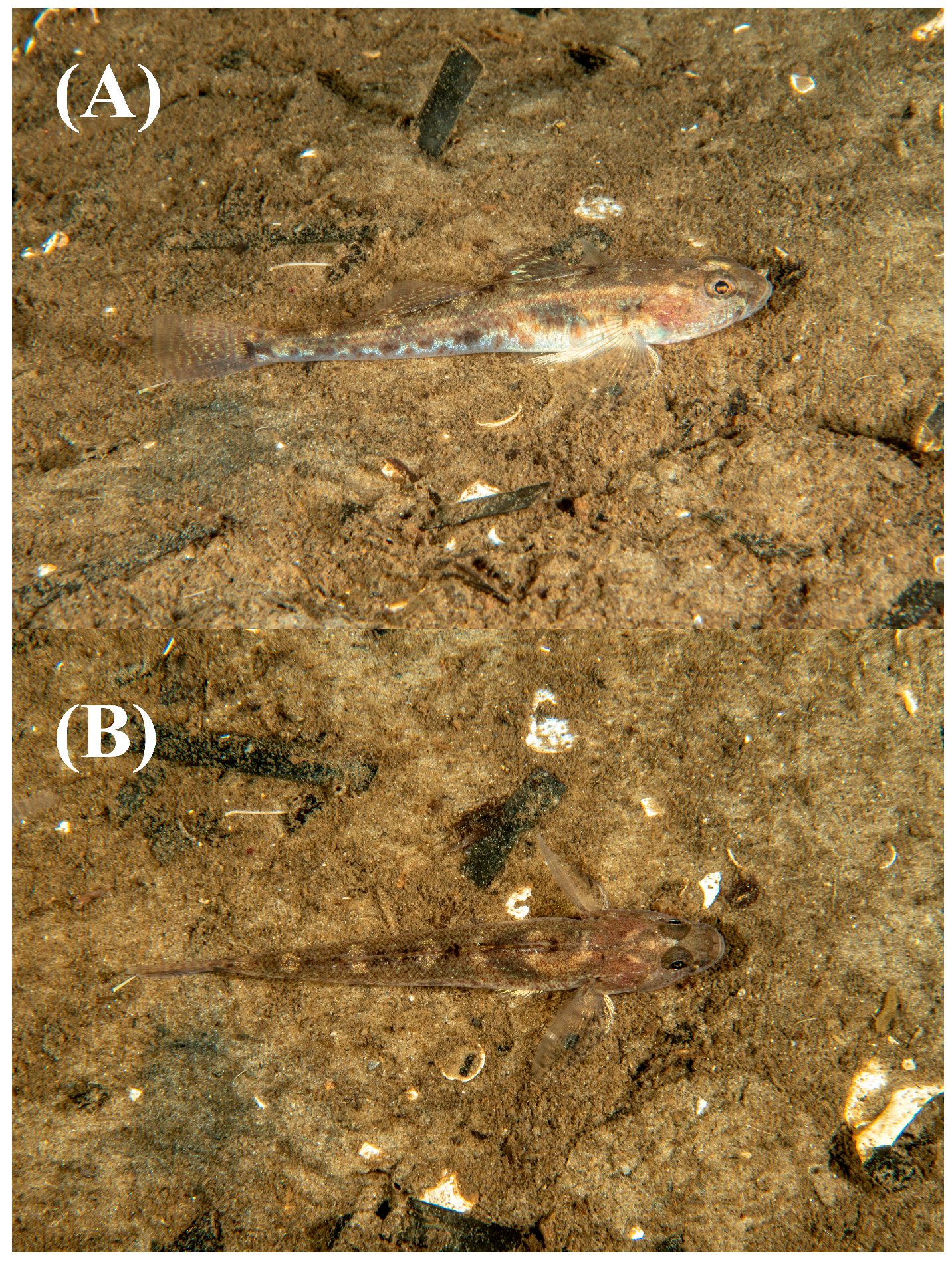
| Adult Male | Adult Female | Juvenile Male | Juvenile Female | Total | |
|---|---|---|---|---|---|
| Area D night | 3 | 0 | 0 | 5 | 8 |
| Area D day | 2 | 1 | 0 | 0 | 3 |
| Area C night | 5 | 3 | 0 | 0 | 8 |
| Area C Day | 0 | 3 | 0 | 1 | 4 |
| Area A day | 2 | 0 | 0 | 1 | 3 |
| Area A night | 2 | 2 | 2 | 0 | 6 |
| Area B day | 2 | 6 | 0 | 0 | 8 |
| Area B night | 2 | 3 | 0 | 1 | 6 |
| Area E day | 3 | 2 | 0 | 0 | 5 |
| Area E night | 1 | 6 | 0 | 0 | 7 |
| Total | 22 | 27 | 2 | 7 | 58 |
| Catalog Number | Area | Day/Night | Depth (Meters) | Sex | Development Stage |
|---|---|---|---|---|---|
| PMR VP5367 | D | Day | 2 | male | adult |
| PMR VP5369 | D | Day | 2 | female | adult |
| PMR VP5371 | D | Day | 2 | male | adult |
| PMR VP5384 | C | Day | 5 | female | juvenile |
| PMR VP5385 | C | Day | 5 | female | adult |
| PMR VP5386 | C | Day | 5 | female | adult |
| PMR VP5388 | C | Day | 5 | female | adult |
| PMR VP5390 | A | Night | 11 | male | adult |
| PMR VP5391 | A | Night | 11 | male | adult |
| PMR VP5392 | A | Night | 11 | male | juvenile |
| PMR VP5393 | A | Night | 11 | male | juvenile |
| PMR VP5394 | A | Night | 11 | female | juvenile |
| PMR VP5395 | A | Night | 11 | female | juvenile |
| PMR VP5396 | B | Night | 11 | female | adult |
| PMR VP5397 | B | Night | 11 | female | adult |
| PMR VP5398 | B | Night | 11 | female | juvenile |
| PMR VP5399 | B | Night | 11 | female | adult |
| PMR VP5400 | B | Night | 11 | male | adult |
| PMR VP5401 | B | Night | 11 | male | adult |
| PMR VP5405 | A | Day | 11 | male | adult |
| PMR VP5408 | A | Day | 11 | male | adult |
| PMR VP5409 | A | Day | 11 | female | juvenile |
| PMR VP5410 | B | Day | 11 | male | adult |
| PMR VP5411 | B | Day | 11 | female | adult |
| PMR VP5412 | B | Day | 11 | female | adult |
| PMR VP5413 | B | Day | 11 | male | adult |
| PMR VP5414 | B | Day | 11 | female | adult |
| PMR VP5415 | B | Day | 11 | female | adult |
| PMR VP5416 | B | Day | 11 | female | adult |
| PMR VP5417 | B | Day | 11 | female | adult |
| PMR VP5418 | D | Night | 2 | male | adult |
| PMR VP5419 | D | Night | 2 | male | adult |
| PMR VP5420 | D | Night | 2 | female | juvenile |
| PMR VP5421 | D | Night | 2 | female | juvenile |
| PMR VP5422 | D | Night | 2 | female | juvenile |
| PMR VP5423 | D | Night | 2 | female | juvenile |
| PMR VP5424 | D | Night | 2 | male | adult |
| PMR VP5425 | D | Night | 2 | female | juvenile |
| PMR VP5568 | C | Night | 5 | male | adult |
| PMR VP5569 | C | Night | 5 | female | adult |
| PMR VP5570 | C | Night | 5 | male | adult |
| PMR VP5571 | C | Night | 5 | male | adult |
| PMR VP5572 | C | Night | 5 | male | adult |
| PMR VP5573 | C | Night | 5 | female | adult |
| PMR VP5574 | C | Night | 5 | male | adult |
| PMR VP5575 | C | Night | 5 | female | adult |
| PMR VP5577 | E | Day | 11.5 | female | adult |
| PMR VP5578 | E | Day | 11.5 | male | adult |
| PMR VP5579 | E | Day | 11.5 | female | adult |
| PMR VP5580 | E | Day | 11.5 | male | adult |
| PMR VP5581 | E | Day | 11.5 | male | adult |
| PMR VP5582 | E | Night | 11.5 | female | adult |
| PMR VP5583 | E | Night | 11.5 | female | adult |
| PMR VP5584 | E | Night | 11.5 | female | adult |
| PMR VP5585 | E | Night | 11.5 | female | adult |
| PMR VP5587 | E | Night | 11.5 | female | adult |
| PMR VP5588 | E | Night | 11.5 | female | adult |
| PMR VP5589 | E | Night | 11.5 | male | adult |
| Source of Variation | Df | MS | Pseudo-F | p (perm) |
|---|---|---|---|---|
| (a) | ||||
| Bottom substrate | 2 | 4.6437 × 10−7 | 18.77 | 1 × 10−4 *** |
| Sex | 1 | 3.7060 × 10−8 | 0.9215 | 0.3432 |
| Developmental stage | 1 | 4.6900 × 10−9 | 0.1149 | 0.894 |
| Time of day | 1 | 1.1090 × 10−8 | 0.2725 | 0.7102 |
| Depth | 1 | 2.9340 × 10−8 | 1.000 | 0.4124 |
| (b) | ||||
| Bottom substrate: FS vs. CMS | 1 | 4.4990 × 10−6 | 7.0953 | 0.002 *** |
| Bottom substrate: FS vs. FSSP | 1 | 6.5679 × 10−6 | 9.3325 | 9 × 10−4 *** |
| Bottom substrate: CMS vs. FSSP | 1 | 4.088 × 10−5 | 27.848 | 1 × 10−4 *** |
| (c) Sex & developmental stage | 3 | 1.0844 × 10−8 | 0.8616 | 0.5063 |
| Source of Variation | Df | MS | Pseudo-F | p (perm) |
|---|---|---|---|---|
| (a) | ||||
| Bottom substrate | 2 | 4.6090 × 10−8 | 1.0766 | 0.356 |
| Sex | 1 | 1.5330 × 10−8 | 0.3531 | 0.603 |
| Developmental stage | 1 | 8.3000 × 10−10 | 0.019 | 0.981 |
| Time of day | 1 | 5.7596 × 10−7 | 17.24 | 0.001 *** |
| Depth | 1 | 1.7471 × 10−7 | 4.3061 | 0.036 * |
| (b) Sex & developmental stage | 3 | 5.2220 × 10−8 | 0. 6518 | 0.74 |
| Source of Variation | Df | MS | Pseudo-F | p (perm) |
|---|---|---|---|---|
| Lateral side | 2 | 6.4875 × 10−8 | 5.2297 | 0.009 ** |
| Dorsal side | 2 | 1.60745 × 10−7 | 7.5227 | 0.002 ** |
Disclaimer/Publisher’s Note: The statements, opinions and data contained in all publications are solely those of the individual author(s) and contributor(s) and not of MDPI and/or the editor(s). MDPI and/or the editor(s) disclaim responsibility for any injury to people or property resulting from any ideas, methods, instructions or products referred to in the content. |
© 2025 by the authors. Licensee MDPI, Basel, Switzerland. This article is an open access article distributed under the terms and conditions of the Creative Commons Attribution (CC BY) license (https://creativecommons.org/licenses/by/4.0/).
Share and Cite
Kovačić, M.; Svensen, R.; Milosaljević, V.; Benac, Č.; Paliska, D. Influence of Bottom Substrate, Bottom Depth and Day/Night on In Situ Coloration Variability of Pomatoschistus minutus (Pallas, 1770) (Actinopterygii: Oxudercidae). J. Mar. Sci. Eng. 2025, 13, 1932. https://doi.org/10.3390/jmse13101932
Kovačić M, Svensen R, Milosaljević V, Benac Č, Paliska D. Influence of Bottom Substrate, Bottom Depth and Day/Night on In Situ Coloration Variability of Pomatoschistus minutus (Pallas, 1770) (Actinopterygii: Oxudercidae). Journal of Marine Science and Engineering. 2025; 13(10):1932. https://doi.org/10.3390/jmse13101932
Chicago/Turabian StyleKovačić, Marcelo, Rudolf Svensen, Vera Milosaljević, Čedomir Benac, and Dejan Paliska. 2025. "Influence of Bottom Substrate, Bottom Depth and Day/Night on In Situ Coloration Variability of Pomatoschistus minutus (Pallas, 1770) (Actinopterygii: Oxudercidae)" Journal of Marine Science and Engineering 13, no. 10: 1932. https://doi.org/10.3390/jmse13101932
APA StyleKovačić, M., Svensen, R., Milosaljević, V., Benac, Č., & Paliska, D. (2025). Influence of Bottom Substrate, Bottom Depth and Day/Night on In Situ Coloration Variability of Pomatoschistus minutus (Pallas, 1770) (Actinopterygii: Oxudercidae). Journal of Marine Science and Engineering, 13(10), 1932. https://doi.org/10.3390/jmse13101932





